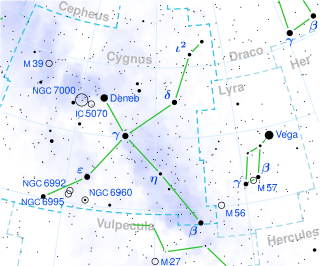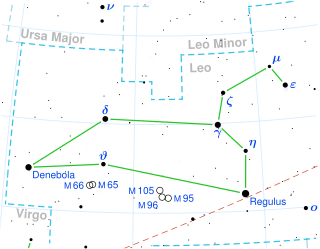Related Research Articles
Gliese 65, also known as Luyten 726-8, is a binary star system that is one of Earth's nearest neighbors, at 8.8 light-years from Earth in the constellation Cetus. The two component stars are both flare stars with the variable star designations BL Ceti and UV Ceti.

63 Andromedae is an Alpha2 Canum Venaticorum variable star in the constellation Andromeda. Its variable star designation is PZ Andromedae. With an apparent magnitude of about 5.6, it is bright enough to be seen by naked eye. Based upon an annual parallax shift of 8.53 mas, it is located 382 light years away.
HD 117207 is a star in the southern constellation Centaurus. With an apparent visual magnitude of 7.24, it is too dim to be visible to the naked eye but can be seen with a small telescope. Based upon parallax measurements, it is located at a distance of 105.4 light-years from the Sun. The star is drifting closer with a radial velocity of −17.4 km/s. It has an absolute magnitude of 4.67.
HD 196050 is a triple star system located in the southern constellation of Pavo. This system has an apparent magnitude of 7.50 and the absolute magnitude is 4.01. It is located at a distance of 165 light-years from the Sun based on parallax, and is drifting further away with a radial velocity of +61 km/s. It is also called by the Hipparcos designation HIP 101806.
HD 6114 is a visual binary star system in the northern constellation of Andromeda. With a combined apparent magnitude of 6.46, the star can only be seen with the naked eye by keen-eyed observers even on the best of nights. Based upon an annual parallax shift of 10.4 mas as seen from Earth's orbit, the system is located approximately 108 parsecs (350 ly) distant.
HD 44594 is a star in the southern constellation Puppis. It has an apparent visual magnitude of 6.64, so it can be seen with the naked eye from the southern hemisphere under good viewing conditions. Based upon parallax measurements, it is located at a distance of 85 light-years from the Earth, giving it an absolute magnitude of 4.56.
Phi2 Ceti, Latinized from φ2 Ceti), is a star located in the equatorial constellation of Cetus. φ2 Ceti is also known as 19 Cet, and HD 4813. Based upon parallax measurements, it is located about 51 light years away. It has an apparent visual magnitude of +5.19, making it bright enough to be seen with the naked eye. The star is drifting further away with a radial velocity of +8 km/s.

Eta2 Coronae Australis, Latinized from η2 Coronae Australis, is a solitary star located in the southern constellation of Corona Australis. It is visible to the naked eye as a dim, blue-white hued star with an apparent visual magnitude of 5.59. Gaia DR3 parallax measurements imply a distance of 770 light years from the Solar System, but it is drifting closer with a radial velocity of −23 km/s. At its current distance Eta2 CrA's brightness is diminished by 0.27 magnitudes due to stellar extinction from interstellar dust and it has an absolute magnitude of −0.24.

ξ Cygni is a spectroscopic binary star in the constellation Cygnus, made up of a K-type supergiant star (primary) and an A-type star (secondary). Its apparent magnitude is 3.73, making it readily visible to the naked eye, and it is located around 350 parsecs (1,100 ly) away.
75 Ceti is a single star in the equatorial constellation of Cetus with at least two planets. It is visible to the naked eye as a dim, orange-hued star with an apparent visual magnitude of +5.36. The star is located 268 light-years distant from the Sun, based on parallax, but is drifting closer with a radial velocity of −6 km/s.
63 Ceti is a star in the constellation of Cetus, located just over a degree south of the celestial equator. With an apparent magnitude of about 5.9, the star is barely visible to the naked eye as a dim, orange-hued point of light. Parallax estimates put it at a distance of about 390 light years away from the Earth, and it is drifting further away with a radial velocity of 28 km/s.

9 Ceti is a star in the equatorial constellation of Cetus. It has the variable star designation BE Ceti, while 9 Ceti is the Flamsteed designation. It has an apparent visual magnitude of 6.4, which is below the limit that can be seen with the naked eye by a typical observer. Based upon parallax measurements, this star is 69.6 light years away from the Sun.
14 Ceti is a single star in the equatorial constellation of Cetus. It is faintly visible to the naked eye under good viewing conditions, having an apparent visual magnitude of 5.84. The distance to 14 Ceti can be estimated from its annual parallax shift of 17.4″, which puts it 187 light years away. It is moving further from the Earth with a heliocentric radial velocity of +11 km/s, having recently come no closer than 178 ly.

HD 193307 is the primary of a binary star located the southern constellation Telescopium. It has an apparent magnitude of 6.27, placing it near the limit for naked eye visibility, even under ideal conditions. The star is located relatively close at a distance of 102 light years based on Gaia DR3 parallax measurements, but it is receding with a heliocentric radial velocity of 16.9 km/s. At its current distance, HD 193307's brightness is diminished by 0.18 magnitudes due to extinction from interstellar dust and it has an absolute magnitude of +3.80. HD 193307 has a relatively high proper motion, moving at a rate of 437 mas/yr.

HD 31134, also designated as HR 1561, is a solitary star located in the northern circumpolar constellation Camelopardalis, the giraffe. It is faintly visible to the naked eye as a white-hued star with an apparent magnitude of 5.74. Gaia DR3 parallax measurements place it 473 light years away. It appears to be approaching the Solar System with a heliocentric radial velocity of −15.1 km/s. At its current distance, HD 31134's brightness is diminished by 0.35 magnitudes due to interstellar dust. It has an absolute magnitude of +0.19.

HD 101917, also designated as HR 4509, or rarely 34 G. Chamaeleontis, is a solitary star located in the southern circumpolar constellation Chamaeleon. It has an apparent magnitude of 6.38, placing it near the limit for naked eye visibility. The object is located relatively close at a distance of 185 light years based on Gaia DR3 parallax measurements but is receding with a heliocentric radial velocity of 33 km/s. At its current distance, HD 101917's brightness is diminished by 0.28 magnitudes due to interstellar dust. It has an absolute magnitude of +2.69.

35 Leonis is a spectroscopic binary star system located in the constellation of Leo, next to the star Zeta Leonis. It is made up of a yellow subgiant star and a red dwarf star, which complete an orbit between each other every 537 days. With an apparent magnitude of 5.97, the system can be naked-eye visible only from dark skies. The distance to 35 Leonis, based from data from Gaia DR3, is 31.83 parsecs (103.8 ly).
HD 37320 is a star located in the constellation Orion. It is an evolved blue giant star, based on its spectral type of B8III. The distance to HD 37320 is calculated at 285.5 parsecs, based on a parallax from Gaia EDR3. The apparent magnitude of the star is 5.852, which is above the limiting magnitude for naked-eye vision (6.5m), making it faintly visible to the naked eye.
HD 85945 is a star in the constellation Ursa Major. It is a yellow giant star with a spectral type of G6III:Fe-0.5. Based on information from Gaia DR3, it is located 132.54 parsecs (432.3 ly) from Earth and is moving towards Earth at a velocity of 47 km/s. It has an apparent magnitude of 5.96, which makes it faintly visible to the naked eye.
HD 18262 is an F-type giant or subgiant star located in the constellation Cetus. It has an apparent magnitude of 5.963, which makes it faintly visible to the naked eye. According to the Gaia spacecraft, HD 18262 is located at a distance of 43.79 parsecs and is moving away from Earth at a velocity of 27.4 km/s. Considering the apparent magnitude and the distance, its absolute magnitude is equivalent to 2.79. It belongs to the thin disk population of the Milky Way.
References
- 1 2 3 4 5 6 7 8 9 10 11 12 13 14 15 16 "64 Ceti". SIMBAD . Centre de données astronomiques de Strasbourg . Retrieved May 7, 2024.
- 1 2 3 4 5 6 7 Deka-Szymankiewicz, B.; Niedzielski, A.; Adamczyk, M.; Adamów, M.; Nowak, G.; Wolszczan, A. (2018-07-01). "The Penn State - Toruń Centre for Astronomy Planet Search stars. IV. Dwarfs and the complete sample". Astronomy and Astrophysics. 615: A31. arXiv: 1801.02899 . doi:10.1051/0004-6361/201731696. ISSN 0004-6361. Data about this star is available here at VizieR.
- 1 2 3 4 5 6 7 8 Vallenari, A.; et al. (Gaia collaboration) (2023). "Gaia Data Release 3. Summary of the content and survey properties". Astronomy and Astrophysics. 674: A1. arXiv: 2208.00211 . Bibcode:2023A&A...674A...1G. doi: 10.1051/0004-6361/202243940 . S2CID 244398875. Gaia DR3 record for this source at VizieR .
- 1 2 3 4 "64 Ceti - Star in Cetus | TheSkyLive.com". theskylive.com. Retrieved 2024-05-07.